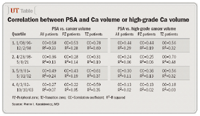Article
Claim that PSA era is over not true, studies show
San Antonio--Thomas Stamey, MD, professor of urology at Stanford (CA) University, more or less threw down the gauntlet last year when he and his colleagues stated in a headline in the Journal of Urology: "The prostate specific antigen era in the U.S. is over for prostate cancer: What happened in the last 20 years?" (J Urol 2004; 172:1297-301).

Researchers from the University of Montreal picked up the gauntlet at the AUA annual meeting by presenting data from a PSA-versus-cancer volume and grade study that appear to refute Dr. Stamey's conclusion.
"These findings indicate that, at least in Europe, the PSA era is not over," said Pierre I. Karakiewicz, MD, assistant professor of urology at the University of Montreal. "Instead, in our opinion, they show that men treated for prostate cancer in Europe have experienced a stage migration that has resulted in a substantial decrease in the amount of high-grade cancer in radical prostatectomy specimens.
Dr. Karakiewicz and colleagues collaborated with Hartwig Huland, MD, and Markus Graefen, MD, urologists at the University of Hamburg, Germany, to conduct a study similar to Dr. Stamey's in a series of 1,448 radical prostatectomy patients. The team assessed the relationship of PSA to both cancer volume and high-grade cancer volume during four quartiles between 1996 and 2003.

"Importantly, there is a substantial decrease in the correlation between PSA and high-grade cancer volume. The drop in high-grade cancer was pronounced and is related to a significant reduction in the volume of high-grade cancer in more recently treated patients. Adjusting for this high-grade cancer volume corrects the drop in the correlation between PSA and cancer volume to an appreciable extent," Dr. Karakiewicz said.
He called attention to a study from Northwestern University, Chicago, presented at the AUA meeting in response to Dr. Stamey's study. This study, presented by William Catalona, MD, looked at 2,187 radical prostatectomy patients who were treated between 1989 and 2004. It found that correlation coefficients were consistently higher for the relationships between PSA and percentage of cancer and for PSA and cancer volume than between PSA and prostate size.
The authors reported that serum PSA correlates more closely with the percentage of prostate cancer and tumor volume in the prostate gland than with prostate size. PSA continues to be a valid serum marker for prostate cancer, they concluded.
Dr. Karakiewicz said that it is noteworthy that the correlation coefficients between PSA and cancer volume were remarkably similar in all three studies.
Dr. Stamey's study looked at 1,317 consecutive radical prostatectomies, divided into four periods between 1983 and 2003. He found that, in the 1980s, when PSA screening began to be widely applied, there were significant relationships between PSA levels and six histologic cancer parameters. By 2000, PSA was related only to prostate size (ie, BPH), he reported.





